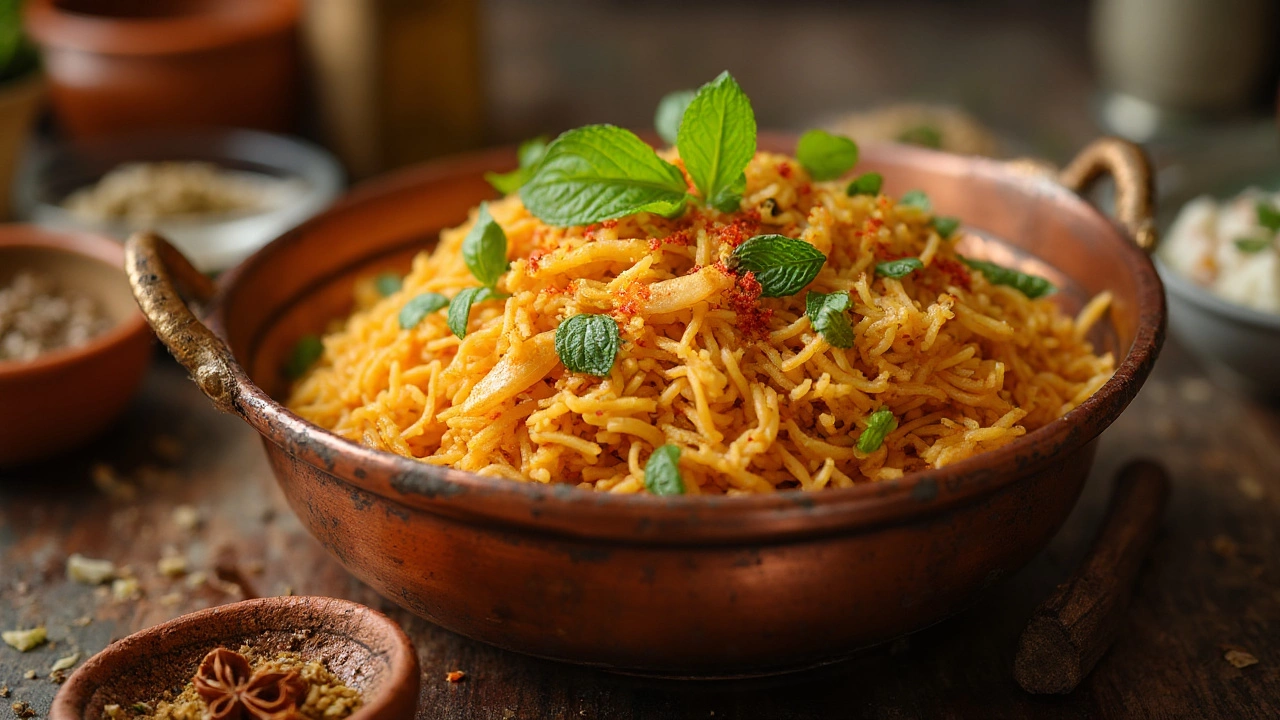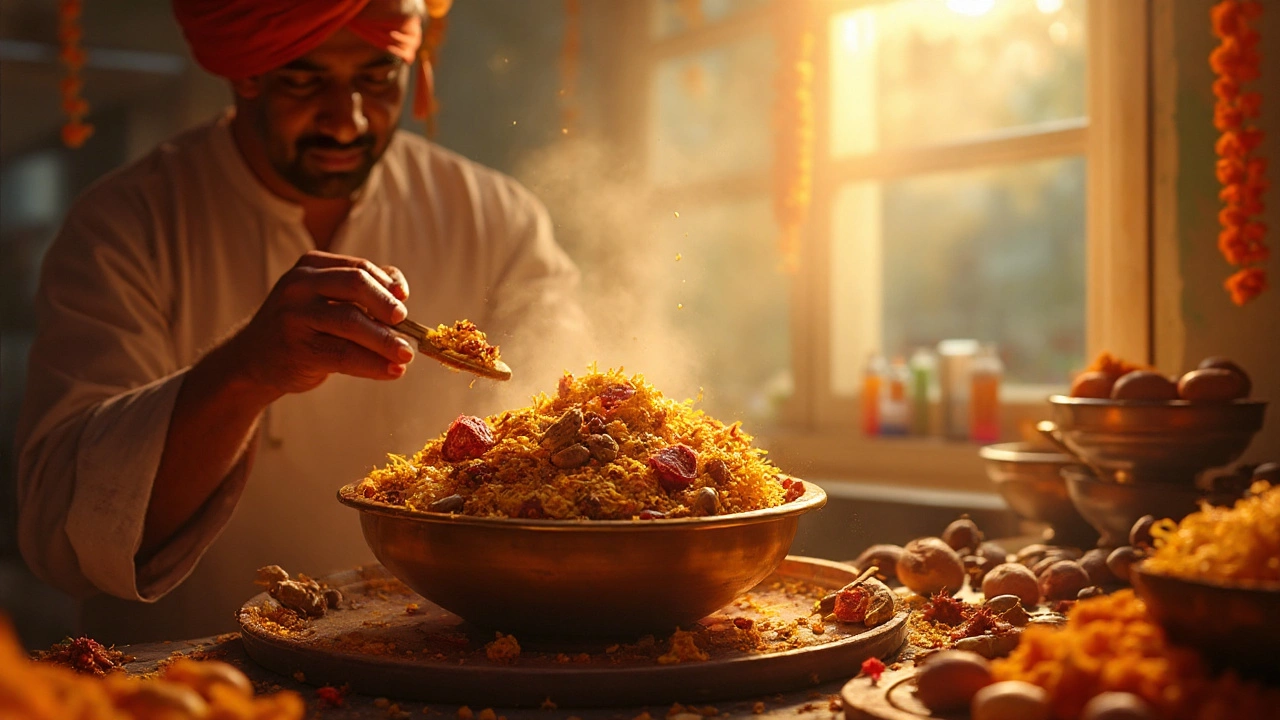Biryani doesn’t quietly arrive on the table. It comes with its own scandal: a trail of aroma that’s basically edible perfume, an explosion of colors, and that little mischief of sizzling, caramelized onions. This isn’t just rice and meat meeting in a pot. If you’ve ever noticed, everyone at a party knows when the biryani’s coming out—even from three rooms away. Yet, try asking ten home cooks for the ‘secret taste’ and you’ll get ten stories, three family feuds, and an aunt who can’t believe you didn’t mention shahi jeera. Is it the spices, the rice, the ghee, or something less obvious—maybe even the hands that stir? Get ready. We’re about to break down the real alchemy that makes biryani so outrageously tasty.
The Symphony of Spices: Building the Biryani Base
The true taste of biryani begins with its spices, and not just any random masala dump. Good biryani doesn’t punch you in the throat with heat; it drapes you in warmth, lingers, and tickles you with notes of clove and cinnamon just when you weren’t ready. The backbone? Basmati rice, marinated protein (mutton, chicken, or paneer), and a blend that often includes cumin, coriander, cardamom, cloves, cinnamon, nutmeg, fennel, bay leaves, and even dried rose or kewra water. If you peek into the kitchen of a Hyderabad home, you’ll spot star anise and stone flower (dagad phool) sneaking into the spice pile—mysterious additions that don’t just flavor but perfume the rice.
What’s wild is how each region adds its own signature. Kolkata biryani is lighter, with subtle potato drama and a hit of fragrance, while Lucknowi biryani is a little more floral, letting the meat and rice flirt instead of compete. But a proper biryani is never just about how many spices go in; it’s how you unlock their oils. Toasting whole spices in hot ghee brings their volatile flavor compounds to life (that’s science speaking). Give them heat and fat, and suddenly all those notes—sweet, spicy, musky—rush out in waves. No shortcut works; powdered spices cheat you out of this burst. Pro tip from my own kitchen: fry the spices until your kitchen smells like you’ve broken into a perfume shop. Only then move on.
Many cooks will say, "Add garam masala last!" The reason is, freshly ground garam masala packs more punch, and you want those top notes to dance, not settle into the background. But the quiet secret? Balance—don’t drown the dish in garam masala. Measure with your nose not your spoons, as my mother always says. When everything’s in harmony, no spice screams; they all sing. Think of biryani as a Bollywood number: everyone gets their solo, but they work best in chorus.
Let’s not ignore the concept of layering. The top layer soaks up saffron and ghee, giving you sweet-scented, luxurious grains, while the bottom gets saturated with meat juices and spice-laden steam. Every spoonful is a surprise. Layering isn’t just about showing off colors; it’s about creating vertical flavor zones. Try drizzling warmed milk mixed with a few strands of saffron over your final rice layer. The little pockets of golden rice you dig up at the end—there’s your “secret.”
The Power of Marination: Unlocking Flavors Deep Inside
Marination is where a lot of people cut corners, only to wonder why their biryani tastes ‘okay’ instead of unforgettable. You can’t just dump raw chicken or mutton into cooked rice and hope for a miracle. The magic starts hours before the biryani pot ever touches the flame. Classic Indian marinades aren’t just about yogurt and salt—they’re chemistry sets. The acidity from yogurt tenderizes the meat, but it also lets it act like a sponge, soaking up garlic, ginger, chili, and spice. My favorite trick: add a squeeze of lime, and a generous pinch of salt. The salt doesn’t just season; it helps break down the meat’s proteins so flavors burrow deep inside.
Time matters. A rushed biryani (30 minutes of marination) will taste nowhere as good as one where the meat rests, preferably overnight in the fridge. Those long hours let the flavors anchor themselves right to the center. Ever had a biryani where meat tastes bland while the rice is bursting with flavor? That’s a marination fail.
But here’s a little-known gem: brown onions are the hidden hero of marination. Fry those onions till they’re crisp, not soggy—caramelized, not burnt. Then, blitz them and fold into the marinade. These onions add a deep sweetness that cuts through the spices and gives biryani that haunting, mouth-watering umami.
If you want to level up, try infusing your yogurt marinade with a bit of mace and nutmeg, used sparingly. Classic Mughlai cooks never skip them; just a hint makes the biryani taste ‘royal’—it’s a flavor you can’t quite name, but suddenly nothing else feels fancy enough. For vegetarians, the same marination principles hold true. Use paneer or jackfruit, and treat it to the marinade party. The result? Every bite tastes like it’s been pampered. Always marinate in a non-reactive bowl, preferably glass or ceramic, so those acids don’t react with metal. Little details, huge flavor payoff.
The upshot? The more you respect marination, the richer and deeper your biryani will taste. That lingering flavor—the one that stays with you hours after you eat—is born in this step.

Layering and Dum Cooking: Where Texture Meets Aroma
The game changes the moment layering comes into play. This isn’t lasagna; it’s more high-stakes. Proper biryani isn’t just rice dump, then meat dump, then stir. The genius is in the gentle hand: partially cooked rice layered with marinated meat, a whisper of saffron milk, little pools of fried onions, mint, and a drizzle of ghee. Here’s where science kicks in. The ‘dum’ (steam) technique transforms everything. Seal the pot—old timers use dough, but a tight-fitting lid does the job if you’re in a rush. The point is, you want to trap all those fragrant volatiles inside. As the biryani gently cooks, steam rises, catches every bit of spice and meat juice, and rains it right back down through the rice.
This dum stage isn’t about speed. It takes patience: 20-30 minutes on low heat, letting rice finish up and meat cook just right. If you mess up and open the lid too early, all those intoxicating aromas rush out and the taste just… flattens. I even place a heavy saucepan on the lid for insurance—a trick from my mother-in-law in Hyderabad, who swears it makes the biryani taste like a banquet.
Texture is the other unsung hero. The best biryani gives you grains that are cooked but distinct, never sticky. The bottom is juicy, almost moist from the absorbed flavors, and the top is fluffy and carries the aroma of saffron and rose water. The layering makes sure that, with every scoop, you get an arrangement—some soft, marinated meat, strands of sweet onion, a few rice grains soaked in ghee, and a breath of cardamom.
The finishing touch? Let your biryani rest off the heat for 10 minutes before serving. It lets the moisture even out so you won’t find one half wet and the other dry. Just before opening the lid, slide in a tiny dab of ghee or butter, cover it back up, and let it melt into the steam. That last sneaky step pulls everything together and gives you a lush aftertaste that’s hard to forget.
Serving biryani properly is another overlooked art. Don’t dump it all out. Slide a flat spatula down the side and gently lift, preserving those beautiful, distinct layers. If you want bonus points, serve with cooling raita and super-thin onion rings with lemon wedges. Tiny things—big impact.
The Intangible Secret: Hand, History, and a Touch of Magic
Here’s where it gets real: the taste of biryani isn’t just what goes in the pot. There’s all this history, memory, and even a bit of soul. I know it sounds cheesy, but food memory is a thing. When I cook biryani, I hear the sizzle of onions like it’s my childhood, and that smell of cinnamon coconut oil reminds me of my first dinner with my future husband, Rohan, when I was so nervous, I almost forgot to soak the rice. Silly mistakes gave the biryani a different texture, but everyone at the table said it tasted "special."
The hands that cook—how they stir, how softly they layer—change the outcome, maybe even more than the recipe. That’s why even with the same ingredients, no two biryanis taste quite the same. Local water, brand of rice, the way you blend spices, your mood—they all sneak in. In fact, some of India’s most beloved biryani cooks guard their method as family treasure. I once read about a grandmother in Tamil Nadu who insists on chanting a prayer before sealing the pot, believing it blesses the rice. There’s no science, just belief—but somehow her biryani really does taste happier.
Biryani also adapts. In wedding feasts, it gets plush—extra ghee, loads of saffron, almonds scattered on top. During festivals, some families even create versions with pineapple or dried apricot, adding a cheeky whisper of sweetness. The street-side versions in Mumbai might use an extra dose of chili, making you reach for water between bites, and yet something about the handlebar-mustached cook’s style keeps you coming back.
That ‘secret taste’ is always shifting, depending on traditions, mood, even the soundtrack playing in your kitchen. But here’s my biggest takeaway: don’t just chase someone else’s recipe. Savor the process. Don’t shy away from layering flavors, marinating long, or going a bit overboard with fried onions. Notice the color, the steam, the first waft—pay attention to what you like best each time. You’ll stumble on your own “secret” soon enough.
The best biryani isn’t just technically perfect—it’s the one laced with hands-on care, a little history, and, always, a bold splash of personality.
